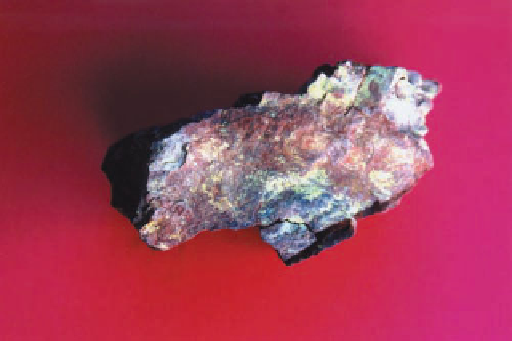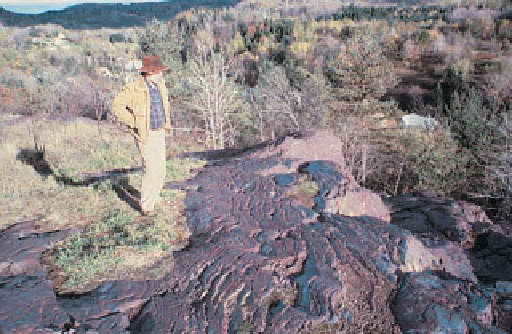Geology Reference
In-Depth Information
◗
Figure 6.30
Carnotite and Banded Iron Formation
b
This banded iron formation at Ishpeming, Michigan, consists of
alternating layers of red chert and silver-colored iron minerals.
a
The yellowish mineral on this piece of petrifi ed wood from
Colorado is carnotite, which is an ore of uranium.
The chemical sedimentary rock known as
banded iron
formation
consists of alternating thin layers of chert and
iron minerals, mostly the iron oxides hematite and magne-
tite (Figure 6.30b). Banded iron formations are present on
all continents and account for most of the iron ore mined in
the world today. Vast banded iron formations are present in
the Lake Superior region of the United States and Canada
and in the Labrador Trough of eastern Canada. We will con-
sider the origin of banded iron formations in Chapter 19.
Chapter Summary
Mechanical and chemical weathering disintegrate and
decompose parent material so that it is more nearly in
equilibrium with new physical and chemical conditions.
The products of weathering include solid particles and
substances in solution.
Mechanical weathering includes such processes as
frost action, pressure release, salt crystal growth,
thermal expansion and contraction, and the activities
of organisms. Particles liberated by mechanical weather-
ing retain the chemical composition of the parent
material.
The chemical weathering processes of solution, oxida-
tion, and hydrolysis bring about chemical changes of the
parent material. Clay minerals and substances in solution
form during chemical weathering.
Mechanical weathering aids chemical weathering by
breaking parent material into smaller pieces, thereby
exposing more surface area.
Mechanical and chemical weathering produce regolith,
some of which is soil if it consists of solids, air, water, and
humus and supports plant growth.
Soils are characterized by horizons that are designated, in
descending order, as O, A, B, and C. Soil horizons differ
from one another in texture, structure, composition, and
color.
Soils called pedalfers develop in humid regions, whereas
arid and semiarid region soils are pedocals. Laterite is a soil
that results from intense chemical weathering in the tropics.
Soil erosion, caused mostly by sheet and rill erosion, is
a problem in some areas. Human practices such as con-
struction, agriculture, and deforestation can accelerate
losses of soil to erosion.
Sedimentary particles are designated in order of decreas-
ing size as gravel, sand, silt, and clay.
Sedimentary particles are rounded and sorted during
transport, although the degree of rounding and sorting
depends on particle size, transport distance, and deposi-
tional process.
Any area in which sediment is deposited is a depositional
environment. Major depositional settings are continental,
transitional, and marine, each of which includes several
specifi c depositional environments.
■
■
■
■
■
■
■
■
■
■
■






Search WWH ::

Custom Search